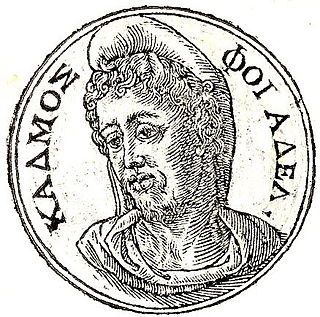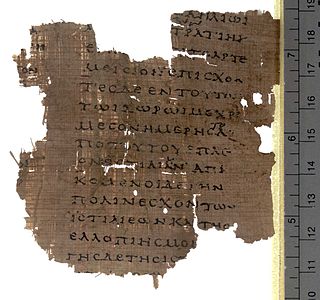Related Research Articles

Herodotus was a Greek historian and geographer from the Greek city of Halicarnassus, part of the Persian Empire and a later citizen of Thurii in modern Calabria (Italy). He is known for having written the Histories – a detailed account of the Greco-Persian Wars. Herodotus was the first writer to perform systematic investigation of historical events. He is referred to as "The Father of History", a title conferred on him by the ancient Roman orator Cicero.

The Battle of Salamis was a naval battle fought between an alliance of Greek city-states under Themistocles and the Persian Empire under King Xerxes in 480 BC. It resulted in a decisive victory for the outnumbered Greeks. The battle was fought in the straits between the mainland and Salamis, an island in the Saronic Gulf near Athens, and marked the high point of the second Persian invasion of Greece.

The phoenix is an immortal bird associated with Greek mythology that cyclically regenerates or is otherwise born again. Associated with the sun, a phoenix obtains new life by rising from the ashes of its predecessor. Some legends say it dies in a show of flames and combustion, others that it simply dies and decomposes before being born again. In the Motif-Index of Folk-Literature, a tool used by folklorists, the phoenix is classified as motif B32.

Necho II of Egypt was a king of the 26th Dynasty, which ruled from Sais. Necho undertook a number of construction projects across his kingdom. In his reign, according to the Greek historian Herodotus, Necho II sent out an expedition of Phoenicians, which in three years sailed from the Red Sea around Africa to the Strait of Gibraltar and back to Egypt. His son, Psammetichus II, upon succession may have removed Necho's name from monuments.

In Greek mythology, Cadmus was the legendary Phoenician founder of Boeotian Thebes. He was, alongside Perseus and Bellerophon, the greatest hero and slayer of monsters before the days of Heracles. Commonly stated to be a prince of Phoenicia, the son of king Agenor and queen Telephassa of Tyre, the brother of Phoenix, Cilix and Europa, Cadmus could trace his origins back to Zeus. Originally, he was sent by his royal parents to seek out and escort his sister Europa back to Tyre after she was abducted from the shores of Phoenicia by Zeus. In early accounts, Cadmus and Europa were instead the children of Phoenix. Cadmus founded or refounded the Greek city of Thebes, the acropolis of which was originally named Cadmeia in his honour.
Gelon also known as Gelo, son of Deinomenes, was a Greek tyrant of the Sicilian cities Gela and Syracuse, and first of the Deinomenid rulers.
Artabazos was a Persian general in the army of Xerxes I, and later satrap of Hellespontine Phrygia under the Achaemenid dynasty, founder of the Pharnacid dynasty of satraps. He was the son of Pharnaces, who was the younger brother of Hystaspes, father of Darius I. Artabazos was therefore a first cousin of the great Achaemenid ruler Darius I.

The Battle of Lade was a naval battle which occurred during the Ionian Revolt, in 494 BC. It was fought between an alliance of the Ionian cities and the Persian Empire of Darius the Great, and resulted in a decisive victory for the Persians which all but ended the revolt.

Polycrates, son of Aeaces, was the tyrant of Samos from the 540s BC to 522 BC. He had a reputation as both a fierce warrior and an enlightened tyrant.

The Histories of Herodotus is considered the founding work of history in Western literature. Written around 430 BC in the Ionic dialect of classical Greek, The Histories serves as a record of the ancient traditions, politics, geography, and clashes of various cultures that were known in Greece, Western Asia and Northern Africa at that time. Although not a fully impartial record, it remains one of the West's most important sources regarding these affairs. Moreover, it established the genre and study of history in the Western world.

Naucratis or Naukratis was a city and trading-post in ancient Egypt, located on the Canopic (western-most) branch of the Nile river, south-east of the Mediterranean sea and the city of Alexandria. Naucratis was the first and, for much of its early history, the only permanent Greek colony in Egypt, serving as a symbiotic nexus for the interchange of Greek and Egyptian art and culture.

The history of the Greek alphabet starts with the adoption of Phoenician letter forms in the 9th–8th centuries BC during early Archaic Greece and continues to the present day. The Greek alphabet was developed during the Iron Age centuries after the loss of Linear B, the syllabic script that was used for writing Mycenaean Greek until the Late Bronze Age collapse and Greek Dark Age. This article concentrates on the development of the alphabet before the modern codification of the standard Greek alphabet.
The traditional Berber religion is the ancient and native set of beliefs and deities adhered to by the Berbers of North Africa. Many ancient Amazigh beliefs were developed locally, whereas others were influenced over time through contact with others like ancient Egyptian religion, or borrowed during antiquity from the Punic religion, Judaism, Iberian mythology, and the Hellenistic religion. The most recent influence came from Islam and religion in pre-Islamic Arabia during the medieval period. Some of the ancient Amazigh beliefs still exist today subtly within the Amazigh popular culture and tradition. Syncretic influences from the traditional Amazigh religion can also be found in certain other faiths.

The siege of Eretria took place in 490 BC, during the first Persian invasion of Greece. The city of Eretria, on Euboea, was besieged by a strong Persian force under the command of Datis and Artaphernes.

Battus I of Cyrene, also known as Battius the Lacedaemonian and Battus Aristotle and Aristaeus (Ἀρισταῖος) was the founder of the Ancient Greek colony of Cyrene. He was its first king, the first Greek king in Africa and the founder of the Battiad dynasty. The butterfly Battus philenor is named after him.
Elbo was, according to Herodotus' Histories, a man-made island of ash and earth where the blind Egyptian king Anysis lived during his 50 years of exile while the Ethiopian king Sabacos ruled Egypt. Supposedly, the island was built up because Egyptians who were bringing food to Anysis were also told to bring him ashes as a gift. Elbo and Anysis are unknown except outside of Herodotus, but Sabacos may refer to Shabaka, a Kushite pharaoh of Egypt's Twenty-fifth Dynasty. As Heroditus states in Book II of his Histories:
140. Then when the Ethiopian had gone away out of Egypt, the blind man came back from the fen-country and began to rule again, having lived there during fifty years upon an island which he had made by heaping up ashes and earth: for whenever any of the Egyptians visited him bringing food, according as it had been appointed to them severally to do without the knowledge of the Ethiopian, he bade them bring also some ashes for their gift. 123ii This island none was able to find before Amyrtaios; that is, for more than seven hundred years 124ii the kings who arose before Amyrtaios were not able to find it. Now the name of this island is Elbo, and its size is ten furlongs each way.

The Lost Army of Cambyses is a legendary Persian army of 50,000 men who supposedly disappeared in a sandstorm in the Western Desert in 524 BC.

The Battle of Pelusium was the first major battle between the Achaemenid Empire and Egypt. This decisive battle transferred the throne of the Pharaohs to Cambyses II of Persia, marking the beginning of the Achaemenid Twenty-seventh Dynasty of Egypt. It was fought near Pelusium, an important city in the eastern extremes of Egypt's Nile Delta, 30 km to the southeast of the modern Port Said, in 525 BC. The battle was preceded and followed by sieges at Gaza and Memphis.
Life of Sethos, Taken from Private Memoirs of the Ancient Egyptians is an influential fantasy novel originally published in six volumes at Paris in 1731 by the French abbé Jean Terrasson. An English translation by Thomas Lediard published at London by J. Walthoe appeared in 1732.

The Achaemenid Empire or Achaemenian Empire, was the ancient Iranian empire founded by Cyrus the Great in 550 BC; the First Persian Empire. Based in Western Asia, it was the largest empire the world had ever seen at its time, spanning a total of 5.5 million square kilometres from the Balkans and Egypt in the west to Central Asia and the Indus Valley in the east.
References
- ↑ Herodotus Histories 2.137